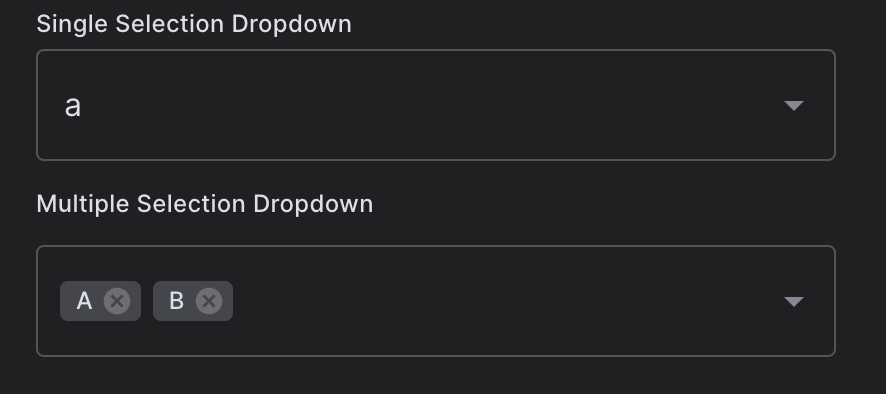dropdown¶
- class virtualitics_sdk.elements.dropdown.Dropdown(options, selected=None, include_nulls_visible=True, include_nulls_value=False, multiselect=False, title='', description='', show_title=True, show_description=True, required=True, label='', placeholder='', max_selections=None)¶
Bases:
InputElementA Dropdown Input element.
- Parameters:
options (
List[Union[int,float,str]]) – The options in the dropdown menu.selected (
Optional[List[Union[int,float,str]]]) – The option the user selected, defaults to [].include_nulls_visible (
bool) – whether null values will be visible, defaults to True.include_nulls_value (
bool) – whether to include null values, defaults to False.multiselect (
bool) – whether the user can select multiple values, defaults to False.title (
str) – The title of the element, defaults to ‘’.description (
str) – The element’s description, defaults to ‘’.show_title (
bool) – whether to show the title on the page when rendered, defaults to True.show_description (
bool) – whether to show the description to the page when rendered, defaults to True.required (
bool) – whether a selection needs to be submitted for the step to continue, defaults to Truelabel (
str) – The label of the element, defaults to ‘’.placeholder (
str) – The placeholder of the element, defaults to ‘’.max_selections (
Optional[int]) – The maximum number of selections that can be made at one time, no limit set by default. This value must be greater than zero.
EXAMPLE
# Imports from virtualitics_sdk import Dropdown . . . # Example usage class ExStep(Step): def run(self, flow_metadata): . . . dropdown_options = ['a', 'b', 'c'] single_selection_dropdown = Dropdown(options=dropdown_options, multiselect=False, title="Single Selection Dropdown", selected=['a']) multiple_selection_dropdown = Dropdown(options=dropdown_options, multiselect=True, title="Multiple Selection Dropdown", selected=['a', 'b'])
The above single and multi Dropdown examples will be displayed as:

- get_value()¶
Get the value of an element. If the user has interacted with the value, the default will be updated.
- Return type:
Union[str,List[str]]
- update_from_input_parameters()¶
- class virtualitics_sdk.elements.dropdown.MultiDropdown(options, selected=None, include_nulls_visible=True, include_nulls_value=False, title='', description='', show_title=True, show_description=True, required=True, label='', placeholder='', max_selections=None)¶
Bases:
DropdownA Multi Dropdown Input element.
- Parameters:
options (
List[Union[int,float,str]]) – The options in the dropdown menu.selected (
Optional[List[Union[int,float,str]]]) – The option the user selected, defaults to [].include_nulls_visible (
bool) – whether null values will be visible, defaults to True.include_nulls_value (
bool) – whether to include null values, defaults to False.title (
str) – The title of the element, defaults to ‘’.description (
str) – The element’s description, defaults to ‘’.show_title (
bool) – whether to show the title on the page when rendered, defaults to True.show_description (
bool) – whether to show the description to the page when rendered, defaults to True.required (
bool) – whether a selection needs to be submitted for the step to continue, defaults to Truelabel (
str) – The label of the element, defaults to ‘’.placeholder (
str) – The placeholder of the element, defaults to ‘’.max_selections (
Optional[int]) – The maximum number of selections that can be made at one time, no limit set by default. This value must be greater than zero.
EXAMPLE
# Imports from virtualitics_sdk import MultiDropdown . . . # Example usage class ExStep(Step): def run(self, flow_metadata): . . . dropdown_options = ['a', 'b', 'c'] multiple_selection_dropdown = MultiDropdown(options=dropdown_options, title="Multiple Selection Dropdown", selected=['a', 'b'])
- class virtualitics_sdk.elements.dropdown.SingleDropdown(options, selected=None, include_nulls_visible=True, include_nulls_value=False, title='', description='', show_title=True, show_description=True, required=True, label='', placeholder='')¶
Bases:
DropdownA Single Dropdown Input element.
- Parameters:
options (
List[Union[int,float,str]]) – The options in the dropdown menu.selected (
Union[int,float,str,None]) – The option the user selected, defaults to None.include_nulls_visible (
bool) – whether null values will be visible, defaults to True.include_nulls_value (
bool) – whether to include null values, defaults to False.title (
str) – The title of the element, defaults to ‘’.description (
str) – The element’s description, defaults to ‘’.show_title (
bool) – whether to show the title on the page when rendered, defaults to True.show_description (
bool) – whether to show the description to the page when rendered, defaults to True.required (
bool) – whether a selection needs to be submitted for the step to continue, defaults to Truelabel (
str) – The label of the element, defaults to ‘’.placeholder (
str) – The placeholder of the element, defaults to ‘’.
EXAMPLE
# Imports from virtualitics_sdk import SingleDropdown . . . # Example usage class ExStep(Step): def run(self, flow_metadata): . . . dropdown_options = ['a', 'b', 'c'] single_selection_dropdown = SingleDropdown(options=dropdown_options, title="Single Selection Dropdown", selected='a')
